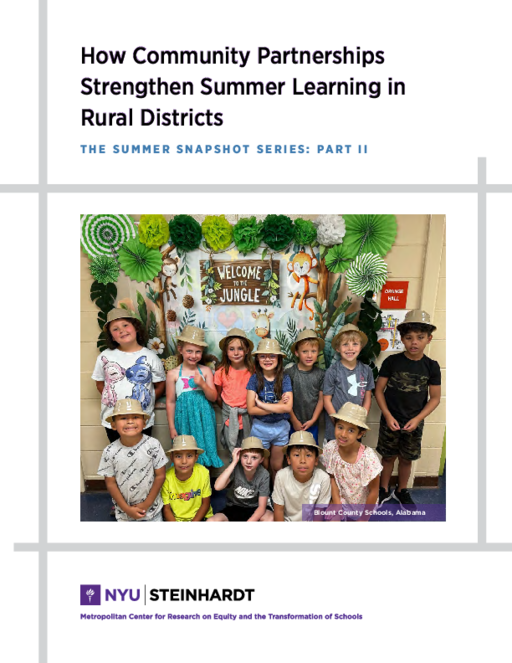Breadcrumb
- Wallace
- Reports
- How Community Partnerships Stren...
How Community Partnerships Strengthen Summer Learning in Rural Districts

Overview
More
Less
- Author(s)
- Sara McAlister, Rhea Almeida, Natasha Berger, and Imani Wilson
- Publisher(s)
- NYU Metro Center's Policy, Research, and Evaluation team
Summary
One-fifth of all students in the United States go to schools in rural areas. And yet, as districts across the country make the shift from traditional summer school to enriching, academically rigorous summer learning, rural communities are often left out of the conversation. This is a missed opportunity because rural districts bring unique assets to the work of creating fun, engaging learning experiences for young people in the summer months.
This summer snapshot, the second in a series, focuses on how four of the 100-plus districts in the Wallace-funded District Summer Learning Network (DSLN) rely on partnerships with community members, local businesses, and tribal nations to fill gaps in access to summer programs and cultural resources. The informal, close-knit nature of relationships in rural communities has enabled these districts to be creative and flexible in how they form and sustain partnerships.
Partnerships serve a number of key functions in rural districts, including supporting academic progress, providing opportunities for career exploration and hands-on learning, and responding to the needs and interests of students and their families. Examples of how the four districts in the snapshot benefit from strong partnerships include:
- Muldrow Public Schools, Oklahoma—The Cherokee Nation funds summer academic programming and provides enrichment activities taught by tribal elders, such as basket weaving and the Native American sport stickball.
- Blount County Schools, Alabama—Firefighters, law enforcement officers, farmers, beekeepers, bankers, doctors, storytellers, artists, and a local Olympic athlete help students explore different career pathways.
- Stigler Public Schools, Oklahoma—The US Army Corps of Engineers offers a water safety program for summer learning students, which earns them and their families free swimming and boating at a nearby natural lake.
- Mountain Empire Unified School District, California—The district responded to student demand for STEM activities by partnering with a remote learning company to provide video game design, coding, and LEGO robotics.
The DSLN helps more than 100 school districts (and six states) design, carry out, and sustain high-quality, evidence-based summer learning programs that prepare students for academic success and support their wellbeing. Funded by The Wallace Foundation, DSLN is designed and led by FHI 360, with NYU Metro Center's Policy, Research and Evaluation team serving as the research partner.

“We are a small rural community, therefore some resources are limited. However, this setting does give us the advantage of knowing everyone and sharing information easily with community partners to ensure our student needs are met.”
— Angela Williams, Federal Programs Director of Muldrow Public Schools
Key Takeaways
- Summer offers opportunities for districts and their partners to connect students with experiences outside the district that are otherwise inaccessible.
- Local partners can expose students to learning opportunities drawn from the natural resources and culture found in their own environment and community.
- Native American nations are often a key support system for rural districts that serve large populations of indigenous students, providing needed resources, academic programming, and expertise in making summer learning culturally relevant.
- Local businesses and community members can offer a wealth of information on career pathways.
- Close-knit relationships and physical proximity help district leaders in rural communities coordinate with partners.



